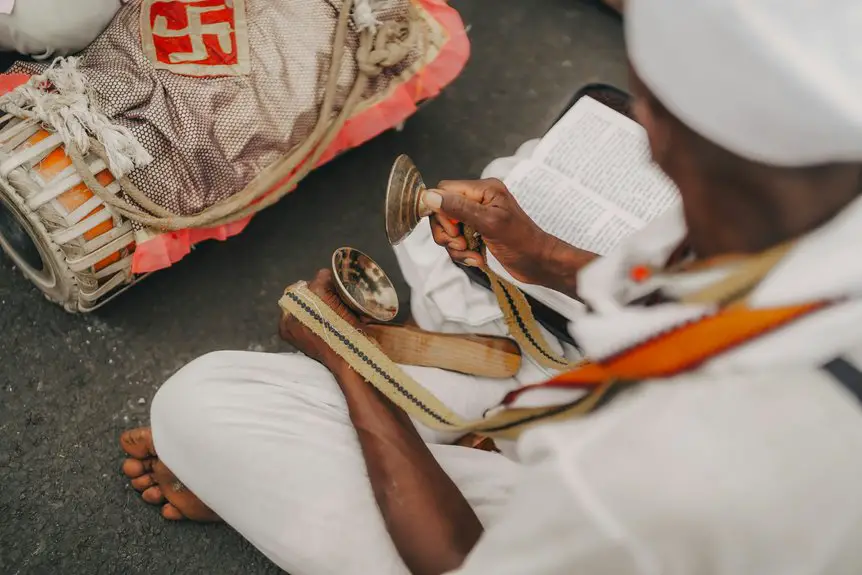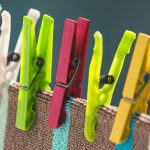You can definitely use woven geotextile fabric for French drains since it effectively filters soil and debris while providing strong soil stability and durability. It helps prevent clogging, supports load distribution, and resists tearing under pressure. However, keep in mind that its tighter weave might limit water flow compared to non-woven options, so proper installation is key. If you want to optimize your drain’s performance and avoid common pitfalls, there’s more useful info to help guide you.
Table of Contents
Key Takeaways
- Woven geotextile fabric is suitable for French drains due to its high tensile strength and soil stabilization properties.
- It effectively filters soil and debris, preventing clogging of gravel and drainage pipes.
- The tight weave may limit water flow compared to non-woven fabrics, potentially affecting drainage efficiency.
- Proper installation includes overlapping edges and securing fabric to prevent shifting and soil infiltration.
- Site-specific conditions and water flow rates should guide fabric choice to ensure long-term drain performance.
Understanding the Role of Geotextile Fabric in French Drains
A woven geotextile fabric plays an essential role in the effectiveness of French drains.
When you install a French drain, you rely on this fabric to prevent soil and debris from clogging the gravel and pipe system. It acts as a filter, allowing water to flow through while holding back fine particles that could reduce drainage efficiency.
Without this barrier, your drain might quickly become blocked, causing water to pool and potentially damage your foundation or landscaping.
By wrapping the drain system with woven geotextile fabric, you guarantee long-term performance and minimize maintenance.
You’ll find that the fabric’s durability and permeability contribute considerably to managing water flow and protecting the drainage infrastructure, making it a critical component in your French drain setup.
Characteristics of Woven Geotextile Fabric
To guarantee your French drain performs well, you need to understand what makes woven geotextile fabric stand out. This fabric is made by weaving polypropylene or polyester fibers, giving it unique strength and durability. It lets water pass through while blocking soil particles, preventing clogging.
Here are key characteristics you should know:
- High tensile strength: Resists tearing and stretching under pressure.
- Porosity: Allows efficient water flow while filtering debris.
- UV resistance: Maintains integrity when exposed to sunlight during installation.
- Chemical resistance: Holds up well against various soil chemicals and contaminants.
Knowing these traits helps you select the right fabric, ensuring your French drain functions effectively over time without unexpected failures.
Benefits of Using Woven Geotextile in Drainage Systems
You’ll find woven geotextile fabric helps stabilize soil by preventing erosion and shifting.
It also improves water flow, allowing your French drain to work more efficiently.
These benefits make it a smart choice for reliable drainage systems.
Soil Stabilization Advantages
Woven geotextile fabric plays an essential role in stabilizing soil within French drain systems, keeping your drainage effective and long-lasting.
When you use this fabric, it reinforces the soil structure around the drain, preventing erosion and soil displacement. This stability guarantees the drain maintains its shape and function over time.
Here’s how woven geotextile benefits soil stabilization:
- Prevents soil particles from mixing with drainage gravel
- Reduces soil erosion caused by water flow
- Supports load distribution, minimizing ground settling
- Enhances soil strength, keeping the trench intact
Enhanced Water Flow
Along with stabilizing soil, geotextile fabric greatly improves water flow within French drain systems.
When you install woven geotextile fabric, it acts as a filter, preventing soil and debris from clogging the drainage pipe. This keeps water moving smoothly and efficiently through the system. You’ll notice fewer blockages and less maintenance over time because the fabric maintains consistent permeability, even under pressure.
The woven structure allows water to pass while holding back fine particles, so your drainage system stays effective longer. By enhancing water flow, you reduce the risk of water pooling or flooding around your foundation or landscape.
Choosing woven geotextile fabric guarantees that your French drain performs reliably, channeling water away quickly and protecting your property from moisture damage.
Potential Drawbacks of Woven Geotextile Fabric
You might face some challenges with woven geotextile fabric, like concerns about its permeability and the risk of soil clogging over time.
It’s also important to evaluate how well it holds up under pressure in your drainage system.
Understanding these drawbacks can help you choose the right material for your French drain.
Permeability Concerns
Although woven geotextile fabric offers strong filtration capabilities, it can sometimes struggle with permeability issues that affect drainage efficiency. When you rely on it for a French drain, these limitations might slow water flow, causing backups or reduced performance.
You should consider these permeability concerns:
- Woven fabric’s tight weave can limit water passage compared to non-woven options
- Over time, sediment can partially block pores, lowering permeability
- High flow rates might overwhelm the fabric, leading to water pooling
- Saturation can reduce fabric effectiveness, especially in heavy clay soils
Soil Clogging Risks
Three main soil clogging risks come with using woven geotextile fabric in your French drain. First, fine soil particles can accumulate and block water flow. Second, organic matter may build up, reducing drainage efficiency. Third, sediment can clog the fabric’s pores over time, diminishing its filtration ability. These issues can lead to poor drainage and costly repairs.
| Risk | Impact on You |
|---|---|
| Fine Soil Particles | Frustration from slow drainage |
| Organic Matter | Worry about recurring maintenance |
| Sediment Build-up | Expense of replacing fabric |
Understanding these risks helps you make informed choices and maintain your French drain effectively.
Durability Under Pressure
While soil clogging can hinder your French drain’s performance, the physical strength of woven geotextile fabric also plays a key role in its long-term effectiveness.
You need fabric that withstands the pressure from soil layers and foot traffic without tearing or compressing. Woven fabrics, though strong, can sometimes face durability issues under heavy loads or shifting soil conditions.
Here are potential drawbacks to weigh:
- Reduced puncture resistance under sharp objects or stones
- Compression leading to decreased permeability over time
- Susceptibility to UV degradation if exposed before covering
- Risk of fabric shifting or tearing during installation
Comparing Woven vs. Non-Woven Geotextile Fabrics
When choosing geotextile fabric for your French drain, understanding the differences between woven and non-woven options can help you make the best decision.
Woven fabrics are made by weaving fibers tightly together, giving them high tensile strength and durability. You’ll find they resist punctures and tears well, making them ideal where soil stability is essential.
On the other hand, non-woven fabrics are produced by bonding fibers randomly, which creates a thicker, more porous material. This design excels at filtration and drainage but lacks the same durability under heavy loads.
Depending on your project’s needs—whether you prioritize strength or filtration—you’ll want to select the fabric that balances these factors.
Choosing correctly guarantees your French drain performs effectively and lasts longer.
How Woven Fabric Affects Water Flow and Filtration
Because woven geotextile fabric features tightly interlaced fibers, it influences water flow and filtration differently than other materials.
Woven geotextile fabric’s tightly interlaced fibers uniquely affect water flow and filtration efficiency.
You’ll find that its structure allows water to pass through efficiently while still blocking soil particles, which helps maintain your French drain’s effectiveness over time.
When you use woven fabric, consider these points:
- Enhances water flow due to its consistent pore size
- Filters fine particles, preventing clogging within the drain
- Offers higher tensile strength, resisting damage during installation
- Supports long-term durability by minimizing sediment buildup
Installation Tips for Woven Geotextile in French Drains
Although installing woven geotextile fabric might seem straightforward, following specific steps guarantees your French drain performs at its best. First, lay the fabric flat without wrinkles to prevent clogging. Overlap edges by at least 12 inches to assure continuous filtration. Secure the fabric with stakes to keep it in place during backfilling. Finally, fold the excess fabric over the gravel before covering with soil to protect your drain from sediment intrusion.
| Step | Tip |
|---|---|
| 1. Prepare trench | Clean debris before placing fabric |
| 2. Lay fabric flat | Avoid wrinkles and folds |
| 3. Overlap edges | 12 inches minimum |
| 4. Secure fabric | Use stakes or pins |
| 5. Fold excess fabric | Cover gravel to prevent clogging |
Environmental Factors Influencing Fabric Performance
You’ll notice that the type of soil around your French drain can greatly affect how well the woven geotextile performs.
Moisture levels and temperature changes also play a big role in the fabric’s durability and function.
Understanding these environmental factors helps you choose the right fabric and extend your drain’s lifespan.
Soil Type Impact
When choosing woven geotextile fabric for your French drain, the type of soil plays a crucial role in how well the fabric performs. Different soils affect filtration and durability, so you need to match the fabric to your specific soil conditions.
For example, sandy soils require a fabric with smaller openings to prevent fine particles from clogging the drain. Clay soils, on the other hand, need a fabric that handles slower water flow without tearing.
Consider these soil factors:
- Particle size and distribution influencing filtration needs
- Soil acidity or alkalinity affecting fabric longevity
- Soil compaction impacting fabric strength requirements
- Presence of organic matter that might degrade the fabric
Moisture and Temperature Effects
Soil conditions set the stage for how your woven geotextile fabric performs, but environmental factors like moisture and temperature also play a big role in its durability and effectiveness. Excess moisture can weaken the fabric’s strength over time, while temperature fluctuations may cause expansion or contraction, potentially leading to tears or deformation. You need to take into account these effects when selecting fabric for your French drain to guarantee long-term reliability.
| Factor | Impact on Fabric | Your Consideration |
|---|---|---|
| High Moisture | Can reduce tensile strength | Choose water-resistant fabric |
| Freezing Temperatures | May cause brittleness | Use frost-resistant materials |
| Heat Exposure | Can soften or deform fabric | Opt for UV-stabilized fabric |
| Temperature Swings | Causes expansion/contraction | Allow for flexibility |
Common Mistakes When Using Woven Geotextile Fabric
Although woven geotextile fabric offers excellent drainage and filtration benefits, many users make avoidable mistakes that reduce its effectiveness.
If you want your French drain to perform well, avoid these common errors:
- Overlapping the fabric too loosely, which allows soil to infiltrate the gravel and clog the system.
- Failing to secure the fabric properly, causing it to shift or tear during installation.
- Using the wrong type or thickness of woven fabric, leading to inadequate filtration or premature wear.
- Ignoring site-specific conditions like soil type and water flow, which can affect fabric choice and placement.
Alternative Materials to Consider for French Drains
If you’re looking for options beyond woven geotextile fabric, several alternative materials can suit your French drain project. You might consider non-woven fabrics, gravel, or even synthetic liners, each offering unique benefits. Non-woven fabrics provide excellent filtration, while gravel improves drainage and stability. Synthetic liners offer durability and prevent soil intrusion. Choosing the right material depends on your soil type, budget, and drainage needs. Here’s a quick comparison to help you decide:
| Material | Pros | Cons |
|---|---|---|
| Non-woven fabric | Great filtration | Less durable |
| Gravel | Enhances drainage | Can be heavy |
| Synthetic liner | Durable, soil barrier | More expensive |
| Sand | Easy to source | Poor filtration |
| Perforated pipe | Direct water flow | Needs proper installation |
Frequently Asked Questions
How Long Does Woven Geotextile Fabric Typically Last in French Drains?
You can expect woven geotextile fabric in French drains to last 20 to 30 years. It’ll resist tearing and clogging, but proper installation and soil conditions play a big role in how long it actually holds up.
Can Woven Geotextile Fabric Be Recycled After Use?
You can recycle woven geotextile fabric, but it depends on local facilities and fabric type. Check with your recycling center to see if they accept this material. Some fabrics might require special handling or disposal methods.
Is Woven Geotextile Fabric Safe for Use Around Drinking Water Sources?
Like a trusted filter, woven geotextile fabric’s safety around drinking water depends on its material. You should choose non-toxic, food-grade types to guarantee no harmful chemicals leach, keeping your water clean and safe.
What Are the Cost Differences Between Woven Geotextile and Other Fabrics?
You’ll find woven geotextile fabric usually costs more upfront than non-woven types, but it’s more durable and reusable. Depending on your project, spending a bit extra now might save you money over time.
How Does Temperature Affect the Durability of Woven Geotextile Fabric?
You’ll find that extreme temperatures can weaken woven geotextile fabric over time. High heat may cause degradation, while freezing can make it brittle. Make certain to choose a fabric rated for your climate to guarantee durability.
- Does Chiffon Fabric Stink - July 15, 2025
- Does Chiffon Fabric Affect the Economy - July 15, 2025
- Does Cotton Fabric Have a Nap - July 15, 2025






